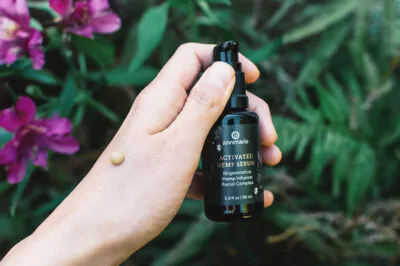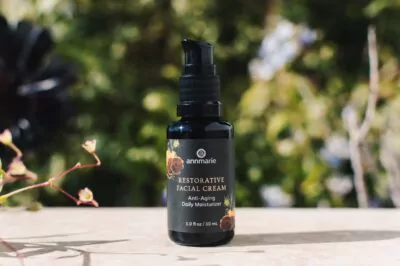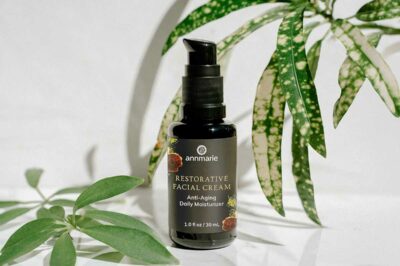Table of Contents[Hide][Show]
- Your Daily Routine
- 1—More people suffer from skin cancer than from any other cancer, period.
- 2—If you have red hair, you’re even more at risk for cancer—and not because you’re fair skinned.
- 3—Sunlight continues to damage skin into the nighttime hours.
- 4—Just two days of exposure to UVA light damages skin at the molecular level—leading to sagging and bagging.
- 5—Regular sunscreen use can prevent wrinkles and dark spots.
You’ve heard it a zillion times. You’re supposed to wear sunscreen every day, all day, rain or shine. And you certainly wear it when you go to the beach, go for a hike, picnic all day in the sun…
But what about when you’re driving, walking to work, or enjoying brunch on the patio?
Sometimes it doesn’t show up for a few months or even a few years, but you can be sure that sun exposure will come back to bite you, with increased fine lines and wrinkles, sagging, and discoloration.
Your Daily Routine
The best thing you can do to keep your skin looking youthful is to wear sunscreen. Every. Single. Day. And this isn’t something you haven’t heard before, we’re just here to remind exactly why it’s so important.
To that end, we did a little research to dig even deeper into just what happens when we skip a day of sunscreen.
It’s a little scary.
1—More people suffer from skin cancer than from any other cancer, period.
Skin cancer is the most common form of cancer in the United States. In 2011, according to the Centers for Disease Control and Prevention (CDC), about 65,500 people were diagnosed with it, and just over 9,000 people died from it.
Did you know that by applying sunscreen, you can cut your risk of melanoma—the most dangerous form of skin cancer—in half? According to a 2011 study from Australia, adults aged 25 to 75 who applied sunscreen every day were half as likely to be diagnosed with melanoma after 10 years than those who just applied it now and then.
In addition, those using sunscreen had a 73 percent lower risk of invasive tumors that penetrated beyond the skin’s surface.
2—If you have red hair, you’re even more at risk for cancer—and not because you’re fair skinned.
Used to be that scientists thought that redheads were more at risk for skin cancer because of their fair skin. But recent studies have shown that it’s even more dangerous than that.
In 2013, for example, researchers discovered that the MC1R gene mutation, which creates red hair and light skin, also promotes an important cancer-causing pathway. In other words, this particular gene, when exposed to UV radiation, actually promotes signaling that may lead to cancer.
In people without red hair, the MC1R gene helps suppress tumors. In redheads, however, who have a mutated MC1R gene, it lacks this protective property, leaving cells open to damage that can lead to cancer. Researchers estimated that red-haired people have a 10-to-100-fold higher frequency of melanoma.
3—Sunlight continues to damage skin into the nighttime hours.
You may think that once you duck out of the sun, you’re safe, but we now know that’s not how it works.
Yes, UV rays can cause damage to your skin cells immediately, but according to a 2015 study, most of the damage occurs hours after sun exposure. Researchers exposed human skin cells (called “melanocytes”) to UV radiation. The radiation damaged DNA immediately, but even hours later in the dark, the melanocytes were still causing damage.
After digging a little deeper, researchers found that UV light activated two enzymes in the skin that excited melanin in cells—the compound that creates skin pigment or color. That “energy” was transferred to DNA in the dark, causing the same damage that sunlight caused in the daytime.
Though this is cutting-edge research, scientists already suggested a solution—apply sunscreen after sun exposure. So if you forget, it’s never too late to help prevent some skin damage!
4—Just two days of exposure to UVA light damages skin at the molecular level—leading to sagging and bagging.
We all think that going out “just this once” without sunscreen won’t hurt us.
Not true, scientists say.
In 2014, researchers showed that one particular type of UV radiation that we’re all exposed to every day can be particularly dangerous to skin cells. They shined a low level of pure UVA1—which makes up most of the UV light in our atmosphere—onto skin samples from human volunteers. The exposure mimicked UVA levels from strong sun exposure lasting about two hours.
The next day, they took tiny samples of the skin to analyze them. They then repeated the process three more times on each participant.
Results showed after just two exposures, the UVA1 rays caused skin cells to create molecules that break down collagen—that skin protein that keeps our skin firm, smooth, and youthful.
The skin darkened in color a little—tanned—but this did not protect the skin from additional damage from the collagen-destroying molecule at the next exposure.
Remember—UVA light is the kind that comes through even on cloudy days, and is most damaging to skin.

5—Regular sunscreen use can prevent wrinkles and dark spots.
Who doesn’t want to prevent wrinkles? Most of us don’t hesitate to slather on the anti-wrinkle creams, but without sunscreen, we could be spinning our wheels.
In case you weren’t sure that sunscreen would really help, we have evidence now. In a 2013 study, researchers compared skin aging in 900 men and women from Australia between 1992 and 1996. Participants who used sunscreen every day—applying a formula with an SPF of 15 or more to hands, face, neck, and arms—were less likely to have wrinkles and dark spots after 4.5 years than those who didn’t, even if they were middle aged.
More specifically, those who used daily sunscreen showed 24 percent less skin aging than those who only used it now and then or not at all. All participants benefited, even those up to 55 years of age.
“We now know that protecting yourself from skin cancer by using sunscreen has the added bonus of keeping you looking young,” said lead study author Dr. Adele Green.
Sources:
“Daily Sunscreen Use Cuts Melanoma Risk in Half, Study Says,” Skin Cancer Foundation, http://www.skincancer.org/news/sunscreen/daily-sunscreen-use-cuts-melanoma-risk-in-half-study-finds.
Adele C. Green, et al., “Reduced Melanoma After Regular Sunscreen Use: Randomized Trial Follow-Up,” Journal of Oncology, January 20, 2011; 29(3):257-263, http://jco.ascopubs.org/content/29/3/257.long.
M.C. B. Hughes, et al., “Sunscreen and Prevention of Skin Aging, A Randomized Trial,” Annals of Internal Medicine, June 4, 2013; 158:781-790, http://annals.org/article.aspx?articleid=1691732.
Juxiang Cao, et al., “MC1R Is a Potent Regulator of PTEN after UV Exposure in Melanocytes,” Cell, August 22, 2013; 51(4):409-422, http://www.cell.com/molecular-cell/abstract/S1097-2765(13)00583-2.
Sanjay Premi, et al., “Chemiexcitation of melanin derivatives induces DNA photoproducts long after UV exposure,” Science, February 20, 2015; 347(6224):842-847, http://www.sciencemag.org/content/347/6224/842.abstract.
Frank Wang, et al., “Dermal Damage Promoted by Repeated Low-Level UV-A1 Exposure Despite Tanning Response in Human Skin,” JAMA Dermatol., 2014; 150(4):401-406, http://archderm.jamanetwork.com/article.aspx?articleid=1782131.









I live in Israel. We have a lot of sun here. The thing to notice with sun exposure as with any other thing, It’s to avoid jumping from one extreme to the other. Not using sun screen or always using it, in my opinion extremes.
Of course there is always different factors for every person, both personal (skin type, health state, etc.) and geographical (Sunny countries, ozone hole, etc.). So common sence should be applied here and for every one and situation there is a different course of action. If you live in Australian in area of ozone hole, then using sunscreen most of the time to protect yourself from overexposure to sun is common sence. On the other hand if you live in a country where there is not enough sunlight and you have vitamind D deficiency then using sunscreen most of the time to protect yourself from something that you badly need is crazy.
There are some general guidelines:
The beauty is from within. Ever heard of that? This is because our body regenerates all the time and if your lifestyle, diet and habits promote premature aging then there are other more important things you should change first.
The best hours to enjoy sun are couple of hours after dawn and before sunset. This is because the sun rays take a longer way thru the earth’s atmosphere and therefore the sun is more “gentle”.
Avoid at all cost traumatic sun exposure to your skin, when it becomes red and after that one layer comes off. This way your skin becomes weaker and it takes very long time to regenerate and it increases risk of having skin problems.
Use only sunscreen with natural ingredients (read the label, products often say natural but have nasty ingredients, such as xenoestrogens that are hormone disaster especially for women).
Did you know that using shoes to run actually makes the ankle weaker? This is because the leg adapts to this additional support and it becomes weaker and increases risk of injury. There is a good book about this called Born to Run by Christopher McDougall, he is a professional runner that used to get injured all the time until he switched his running technique to barefoot like the tarahumara indians, after that he wasn’t injured even one time. Why I’m saying this? Because with the skin it’s exactly the same. By putting sunscreen all the time, your skin adapts to this additional support and becomes weaker and thinner. On the other hand if you use sunscreen smartly to avoid over exposure you make your skin more stronger and it adapts to this new state. It’s exactly the same with any muscle.
There are many more known and unknown benefits anyone can get from proper sun exposure and it’s not only vitamin D. By now science just discovered the tip of the iceberg here.
Here are good links to help you out:
Drinking carrot juice can protect your skin from the sun
http://www.naturalhealth365.com/juicing_benefits/protect-your-skin-1083.html
BioAstin Astaxanthin acts as an internal sunscreen
http://www.naturalhealth365.com/nutrition_news/bioastin-astaxanthin-skin-health-1089.html
Diet:
Documentary- Forks over knives
http://www.forksoverknives.com/
Wish Health and Happines,
Valentine.
Hi, I am very interested in this subject as I have rather sensitive skin which showed a few years ago even signs of sun allergy. I then started reading around as to understand the reason and to find a solution and an adequate sunscreen. Of course, I was shocked to learn that some ingredients in sunscreen can cause skin cancer !! It was suggested to use physical UV blockers instead of chemical ones as they do not penetrate into the skin. In this sunscreen titanoxide and zinkoxide are used as nanoparts. BUT, new studies apparently show that titanoxide nanoparts can damage the DNA and “zinc oxide, a common ingredient in sunscreens, undergoes a chemical reaction that may release unstable molecules known as free radicals and those free radicals can kill cells” (Cell toxicity studies by Dr. Yinfa Ma, Curators’ Teaching Professor of chemistry at Missouri S&T). As it is often the case, more extensive study is needed… and until then our health is suffering. In the EU, as of 2013, nanoparts have to be declared – may be, they are not as harmless as one may think…? I feel like getting in a vicious circle….We solve one problem and create another instead….?
Can you recommend a safe sunscreen for the rest of your body since Sun Love is intended for your face. Thank you for the informative article and as a redhead…. I have been way too casual about sun exposure!
My comment was not being directed at your product but mostly addressing the article you posted. I felt it is a biased one sided study leaving your readers without all the facts concerning sun exposure.
I just had two surgeries on my nose to deal with a basal cell carcinoma. Six years ago I had two surgeries on a basal cell next to my eye. (scary) Basal cell carcinomas are not life threatening, but their growth and removal of them is costly and can be quite disfiguring. Insurace may pay for the MOHS surgery but often doesnt pay much toward the Pastic surgery to close the hole that is left. I played tennis, hiked, biked and sunbathed -like many baby boomers – with little to no sunscreen, until six years ago. I didn’t understand about all the different kinds of skin “cancers” out there – especially when I was baking in the sun at the age of 18! As you might guess, I’m not as concerned about D3 deficiency as I am about skin cancers and the surgeries they may require. Your situation may be different, but at the very least it seems smart to carry some “pure” sunscreen with you in case you are in the sun in the middle of the day longer than you initially intended. After trying MANY sunscreens, I decided to use Sun Love everyday ( as well as some way cool hats)!!!
Getting Vit D exclusively from the sun is a noble idea but not necessarily possible. I have experimented with this in TX and sun exposure has failed to raise my Vit D levels at all. Geography comes into play as a variable and most of us are simply too far from the equator for sun exposure to raise serum Vit D levels. Raise Vit D levels by taking Vit D 3. Keep in mind that the RDA is woefully low. Do your research to determine the amount to take daily to raise your levels and then have it checked with a blood draw.
Although sunscreen might be useful when being in the sun for longer periods it seems not very natural to me wearing it all the time. How would it be possible for all women in the world to afford this and what about our ancesters? I think people in Australia and USA are all afraid for skincancer, not here in Europe (I live in France) Is not it a big hype?
Hi Marja!
I would guess that our ancestors probably favored sun protection methods like wearing protective clothing or finding shade under trees. Which are also things you can do to protect your skin from the sun now. 🙂
You’re right, in some areas of the world, sun protection is much more talked about. Australia’s location and the depletion of the ozone layer make sun protection a much bigger issue there.
Wearing sunscreen every day might seem excessive to some. What we love about Sun Love is that it doesn’t feel like a sunscreen at all! (And it’s not, technically, since it’s not SPF rated.) It has an amazing, creamy consistency and tons of anti-aging herbs, plus hyaluronic acid (which helps your skin retain water and stay plump). So it really just feels like you’re using a lotion that makes your skin glow and happens to have zinc oxide in it (which provides protection from both UVB and UVA rays.)
Sun Love is meant mainly for your face, and a little goes a long way, so each bottle can last you quite a long time! (Really though, you only need a small bit for each application.)
I totally agree with Cheryl. Cancer is caused by Vitamin D deficiency and also high sugar consumption. Sugar feeds cancer!
It’s because of sunscreen that cancer is on the rise. Most people are Vitamin D deficient. Sun exposure also lowers cholesterol and strengthens the immune system to prevent flus, colds and cancer.
What would you rather have: a few wrinkles or cancer?
You could protect your face with a hat if you are concerned about wrinkles, as long as the rest of the body gets proper sun exposure.
This is all very interesting, but not in a good way. There is this proliferation of vitamin D deficiency in our world and one of the reasons for that is because of this mantra to “always wear sunscreen”. It’s even worse for people with darker skin. It doesn’t matter whether the sunscreen is natural or synthetic, shouldn’t there be a limit to the use of this stuff. How on earth are people supposed to make natural vitamin D when they slather this stuff on their bodies all day every day and now night. Sun exposure is obviously the best way to get the vitamin as opposed to supplementation of course with good judgment. Tell me where do we draw the line.
Hi Cheryl!
You’re right, Vitamin D deficiency is really common these days! Did you know that removing the natural oils from your skin is a part of this problem? Vitamin D is a fat soluble vitamin, so your body uses oils to absorb it. So if you use a harsh soap, like those containing sodium lauryl sulfate, you diminish your absorption of Vitamin D from the sun. We recommend using gentle cleansers instead.
Additionally, Sun Love is best used on the face, given that it’s tinted. Since your face is constantly exposed to the elements, it is extra important to protect it from the sun in order to prevent premature aging. So when we say to use sun protection each and every single day, we’re especially referring to on your face. 🙂
I would be interested in the response to this as well.
How are you supposed to get your vitamin D from sun if you stay out of it or wear sunscreen?